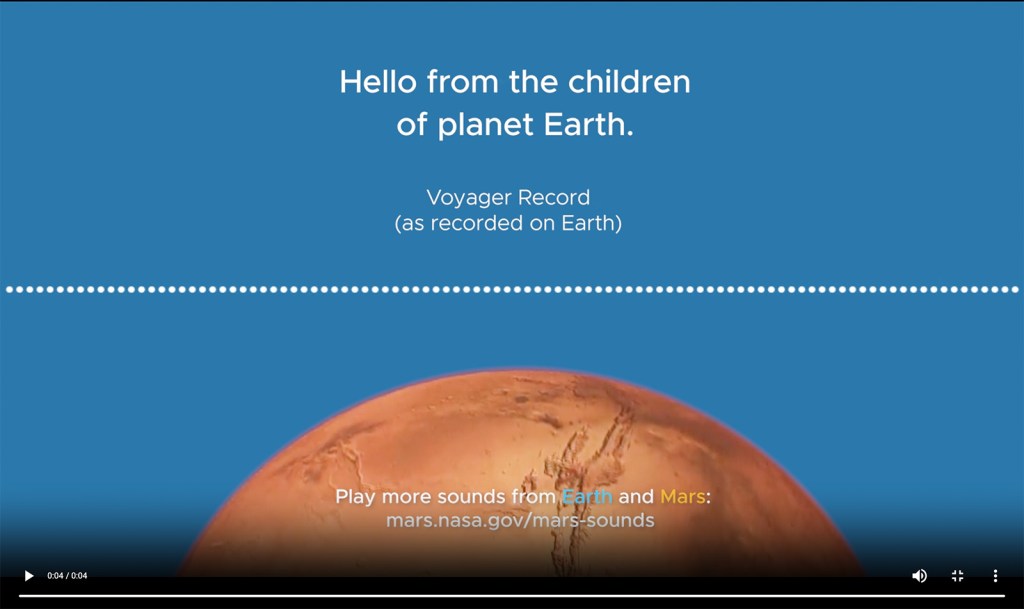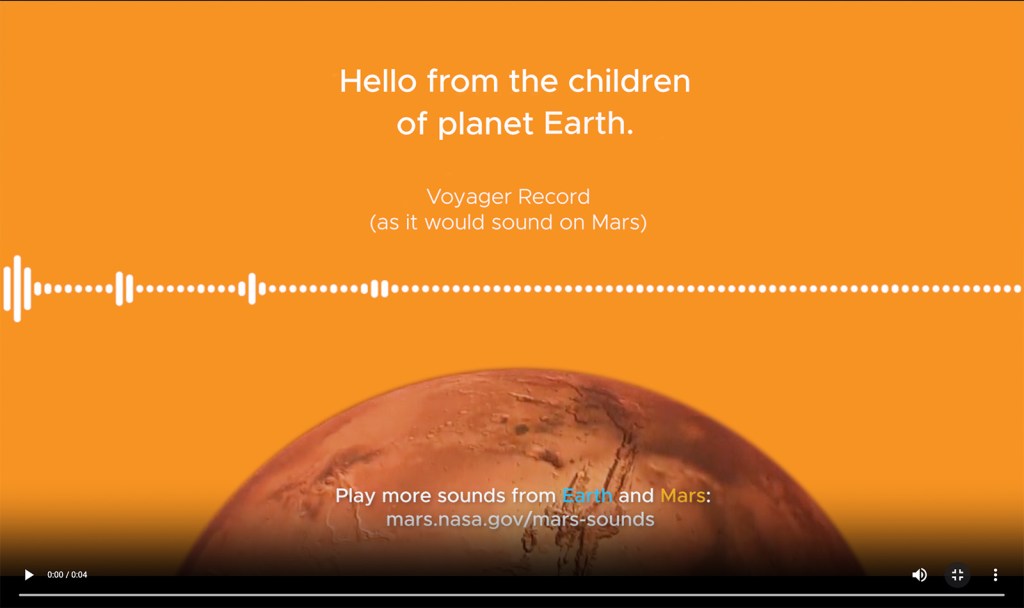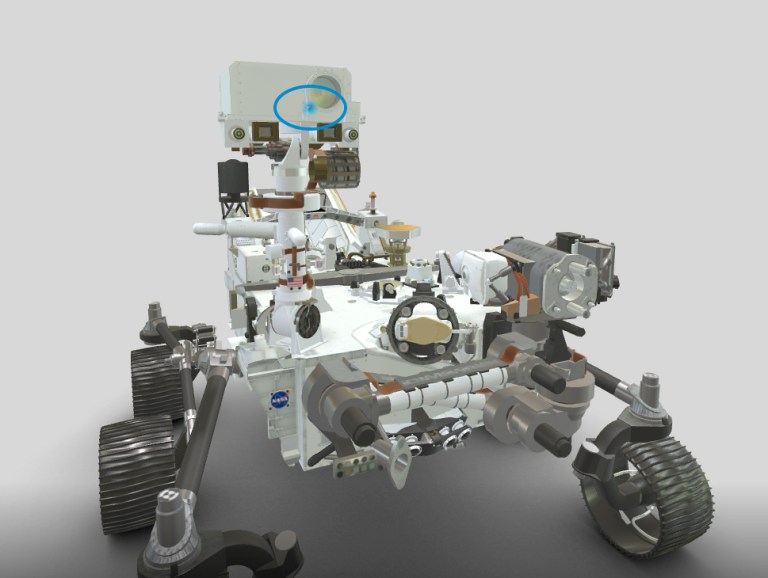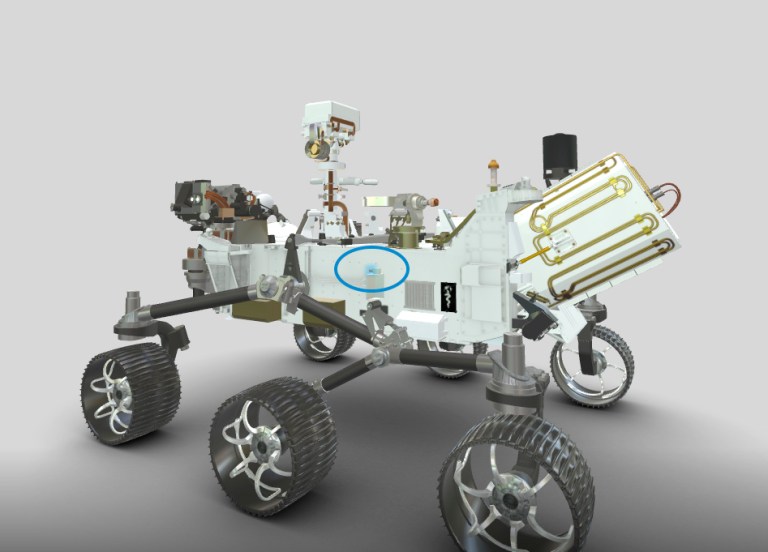Sounds of Mars
Overview
The Perseverance rover carries two microphones, letting us directly record the sounds of Mars for the very first time. Even though Earth and Mars are entirely different planets, it may be comforting to know that if you were on Mars, you might still sound pretty much like yourself. If you were standing on Mars, you’d hear a quieter, more muffled version of what you’d hear on Earth, and you’d wait slightly longer to hear it. On Mars, the atmosphere is entirely different. But, the biggest change to audio would be to high-pitch sounds, higher than most voices. Some sounds that we’re used to on Earth, like whistles, bells or bird songs, would almost be inaudible on Mars.
Hello from the children of planet Earth
As it would sound on Earth
NASA attached golden records to each of the twin Voyager spacecraft before they launched in 1977. The purpose was to send a message from Earth to any spacefarers that might find the spacecraft in the future. In addition to images, music, and sounds from Earth, greetings in 55 languages were aboard, including this one in English.

Hello from the children of planet Earth
As it would sound on Mars
NASA attached golden records to each of the twin Voyager spacecraft before they launched in 1977. The purpose was to send a message from Earth to any spacefarers that might find the spacecraft in the future. In addition to images, music, and sounds from Earth, greetings in 55 languages were aboard, including this one in English.

How does sound work?
When we hear sound, what we’re really experiencing is our eardrums vibrating. That vibration comes from waves of pressure that travel to our ears from the source of the sound. To get to our ears, the waves need something to travel through, like air. Sound waves can travel through liquids and even solids, but most of what we hear comes through the air.
What’s different about Mars?
Mars has an unusual atmosphere compared to Earth, with very different temperature, density, and chemistry. These differences would have three main effects on the sound you’d hear:
Speed of Sound
Sounds emitted in the cold Martian atmosphere would take slightly longer to get to your ear. With an average surface temperature around -81 F (-63 C), Mars has a lower speed of sound, around 540 mph (~240 meters per second), compared to about 760 mph (~340 meters per second) on Earth. You probably wouldn’t notice up close, but over longer distances you might.
Volume
The sound level you'd hear would be automatically lower on Mars. The Martian atmosphere is about 100 times less dense than on Earth -- that is, there’s just a lot less of it. That affects how sound waves travel from the source to the detector, resulting in a softer signal. On Mars you’d have to be much closer to the source of a sound to hear it at the same volume as you would on Earth.
Sound Quality
The atmosphere of Mars, made up of 96 percent carbon dioxide, would absorb a lot of higher-pitched sounds, so only lower-pitched sounds would travel long distances. This effect is known as attenuation -- a weakening of the signal at certain frequencies -- and it would be more noticeable the farther you were from the source.
Put together, these three impacts would change how you would sound in the atmosphere of Mars. Of course, if you found yourself on Mars, you’d have a spacesuit on. Not only would it help with clear radio communication, but you’d be able to breathe as well!
What does Mars actually sound like?
Did you know sound works differently on Mars than it does on Earth? Mars has a different atmosphere than Earth, so sounds on the Red Planet would sound a bit different and be more muffled. Perseverance has captured sounds such as dust devils, the whir of the Ingenuity Mars Helicopter in flight, and the sound of its wheels crunching over the rocky Martian terrain.
Learn More-
Mic for Science
One microphone is part of the SuperCam instrument, on top of the rover’s mast. SuperCam fires a laser at distant rock targets to help determine what they’re made of. Scientists have recorded the sounds of the laser hitting a rock target. Variations in the sounds of that laser pop give clues to the rock hardness, mass and type. This mic has also captured the sounds of Martian wind.
Image Caption: The SuperCam microphone, highlighted in blue, at the top of the rover’s mast. Credit: NASA/JPL-Caltech The SuperCam microphone, highlighted in blue, at the top of the rover’s mast.
The SuperCam microphone, highlighted in blue, at the top of the rover’s mast. -
Mic to Record Landing
The team added an additional experimental, off-the-shelf commercial microphone to the side of the rover, to record the sounds of Entry, Descent, and Landing. While it wasn’t able to collect audio from the turbulent entry and descent, this microphone did survive the landing, and has recorded additional sounds of the rover on Mars.
Image Caption: The EDL microphone, highlighted in blue, attached to the left side of the rover. Credit: NASA/JPL-Caltech The EDL microphone, highlighted in blue, attached to the left side of the rover.
The EDL microphone, highlighted in blue, attached to the left side of the rover.






























